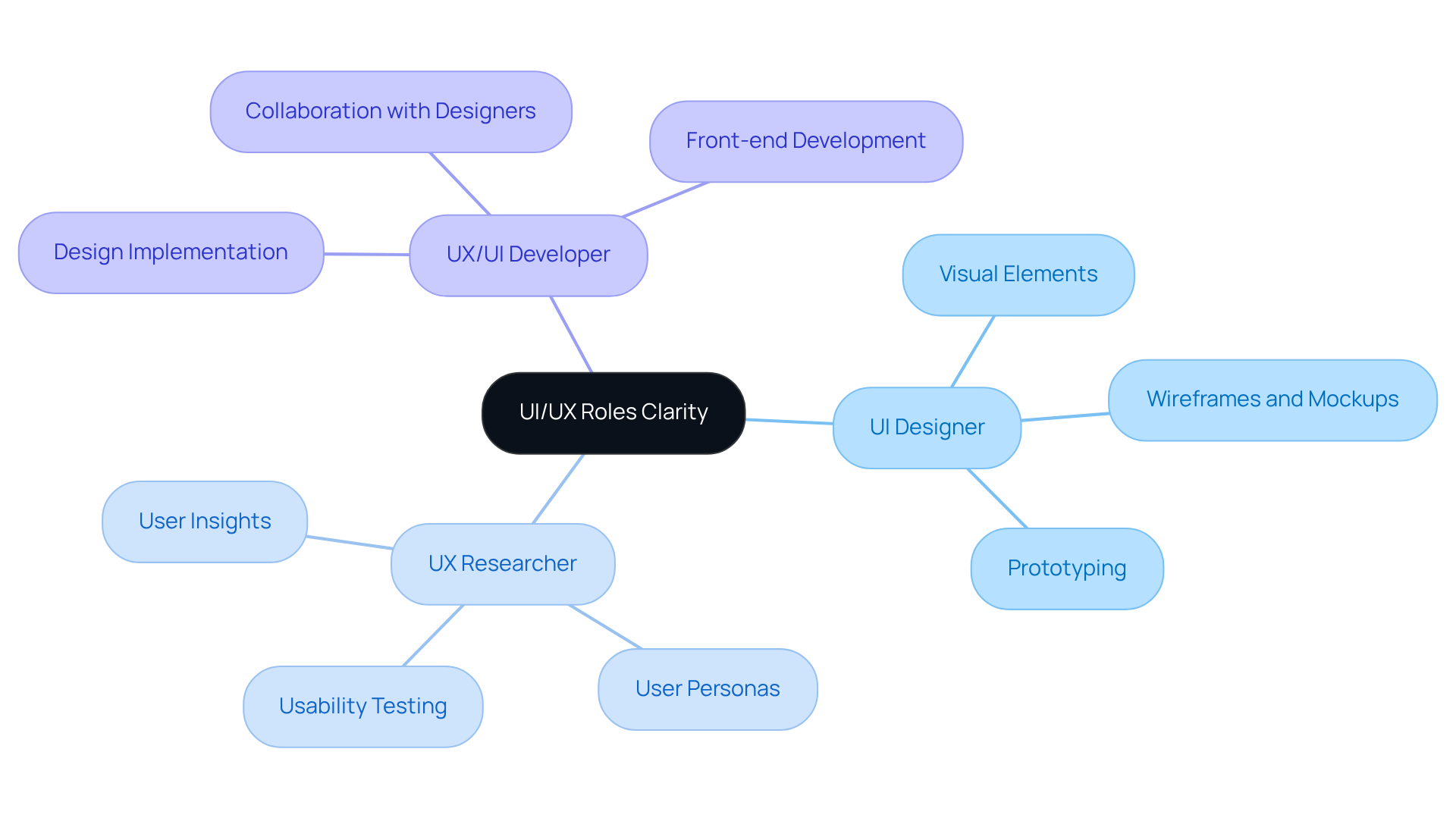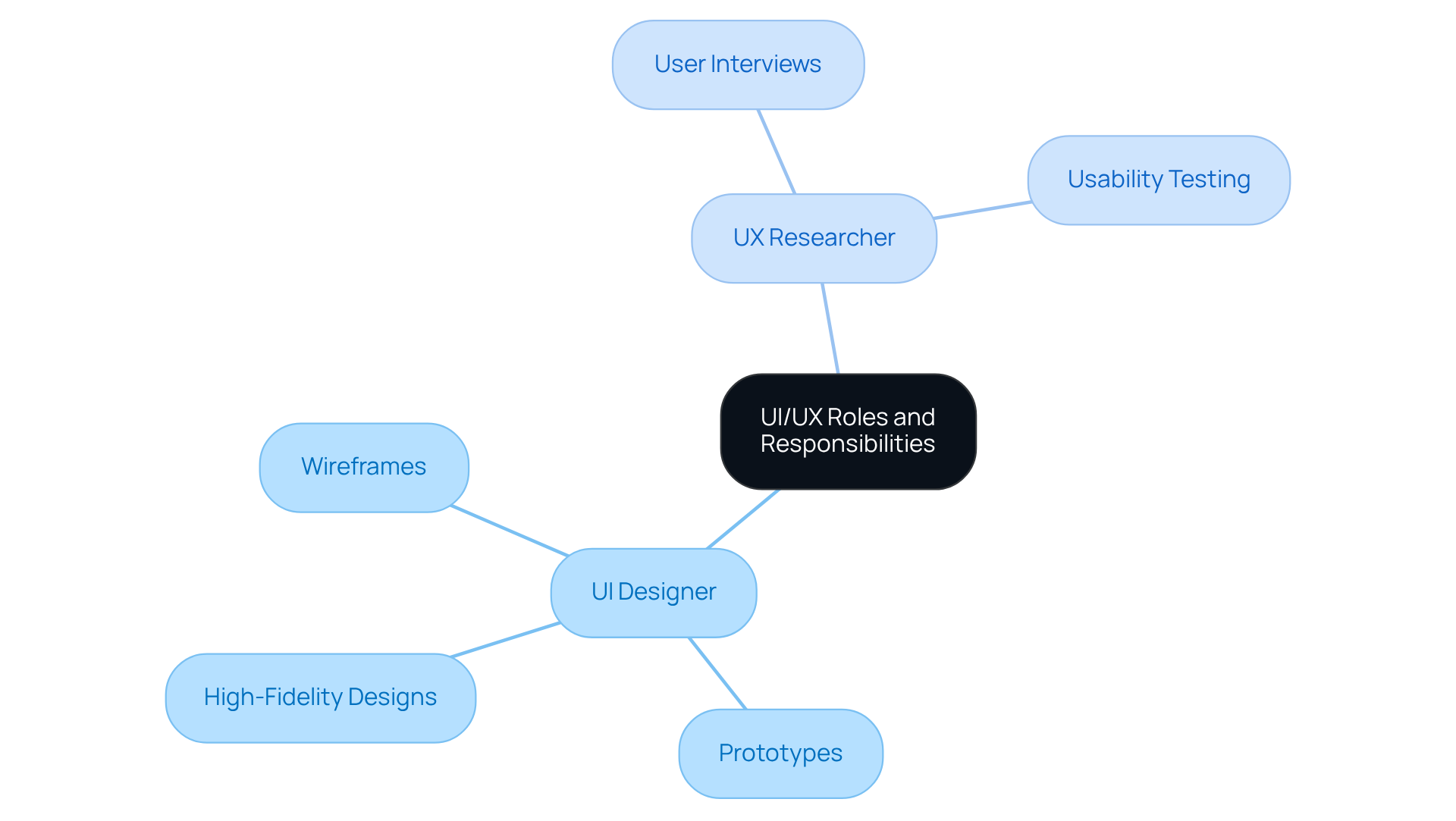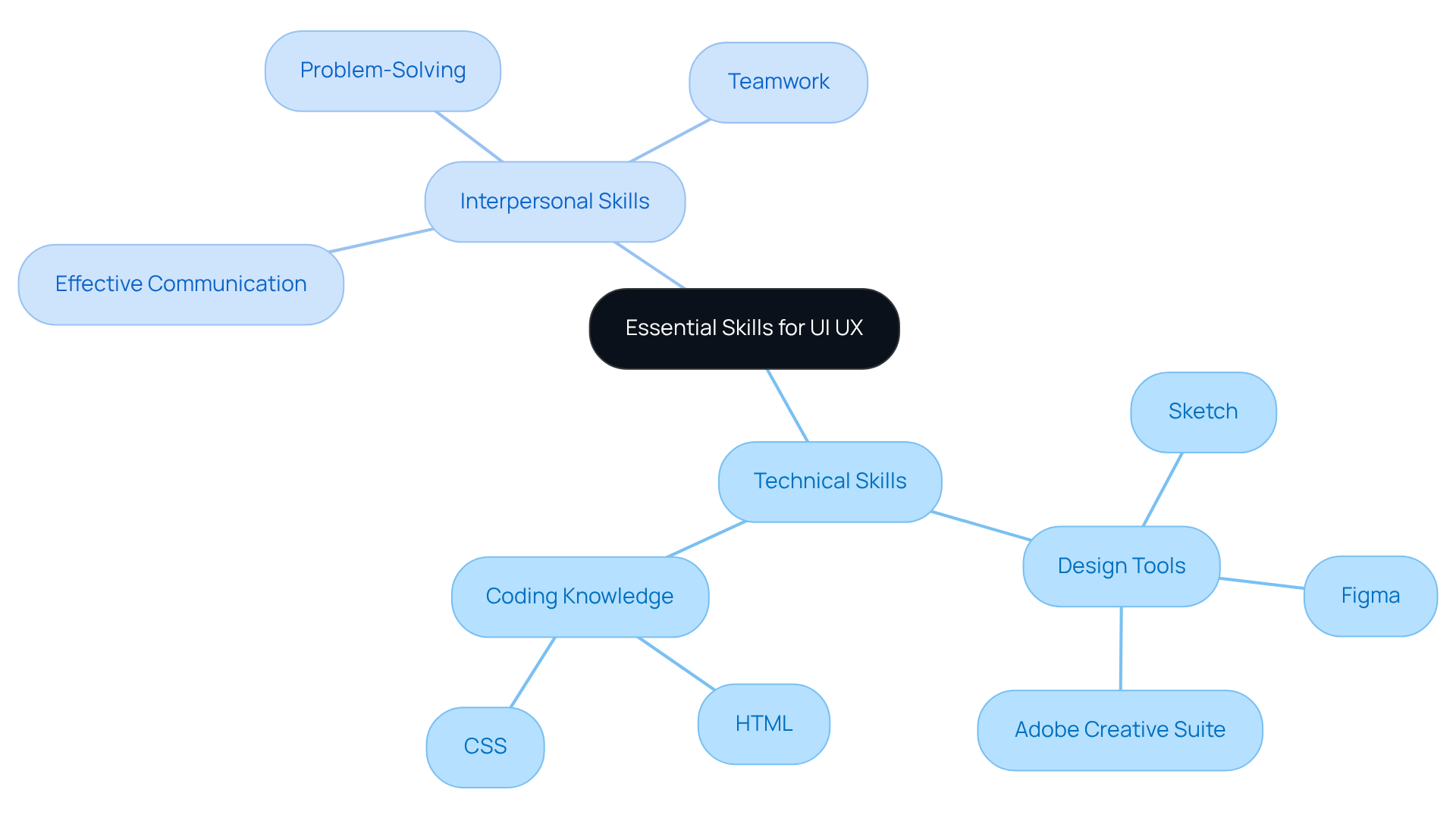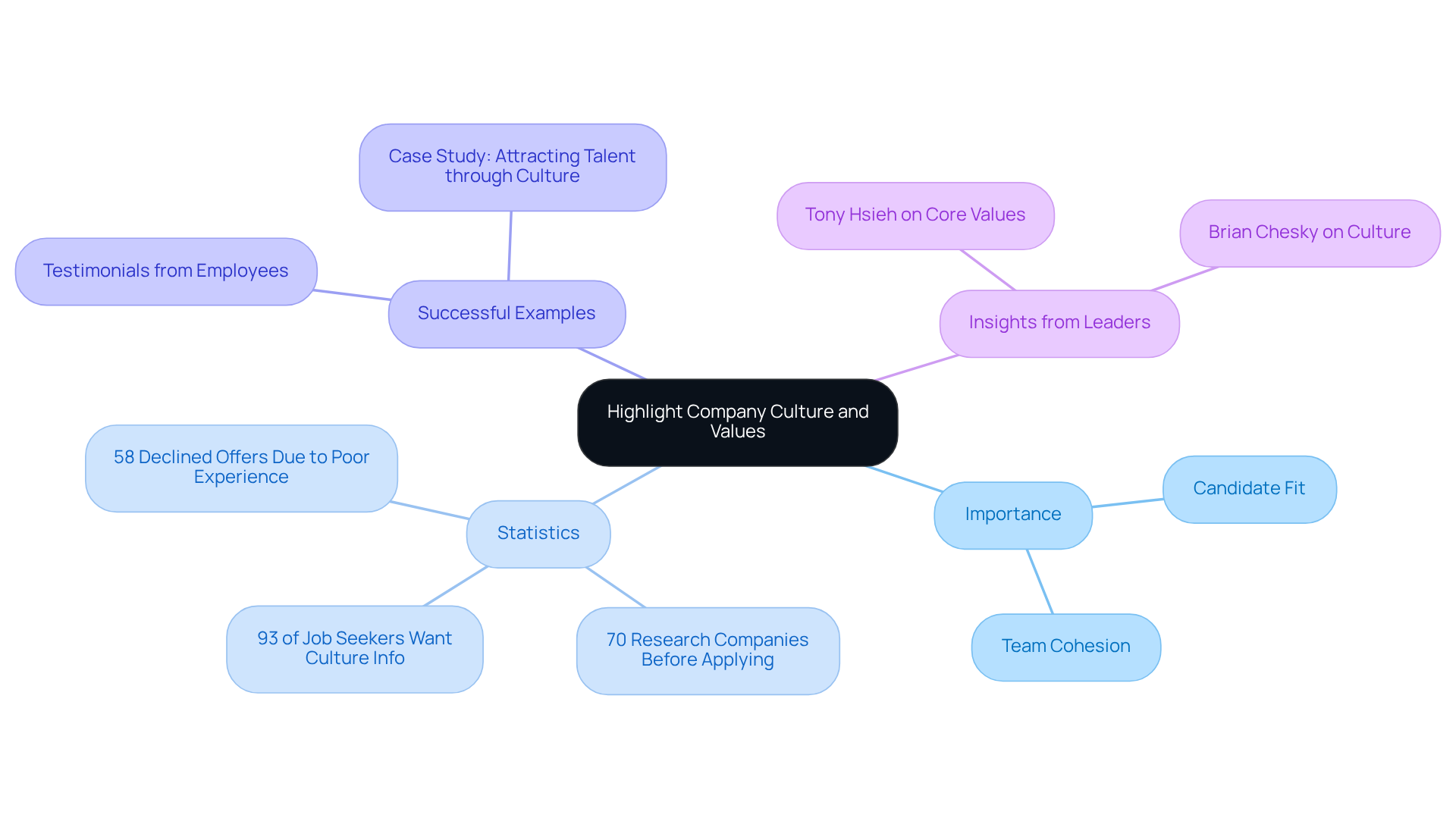Overview
In the world of startups, crafting effective UI/UX vacancy descriptions can often feel overwhelming. Many founders struggle to clearly define roles and responsibilities, which can lead to confusion and misalignment within the team. This lack of clarity not only affects recruitment efforts but can also impact the overall work environment, making it challenging to attract the right talent.
By emphasizing essential skills and the unique aspects of company culture, startups can create job descriptions that resonate with potential candidates. This nurturing approach not only clarifies expectations but also highlights the organizational values that foster a productive work environment.
Ultimately, by providing this clarity, startups can enhance their recruitment success and team efficiency, creating a supportive community that nurtures growth and innovation.
Introduction
In the competitive landscape of tech startups, the clarity of UI/UX vacancy descriptions can truly make or break a recruitment effort. Many startups find themselves grappling with the challenge of defining roles and responsibilities that not only attract the right talent but also resonate with their organizational goals. This can lead to frustration and uncertainty, leaving founders feeling overwhelmed.
However, by honing in on the essential skills, qualifications, and company culture, these businesses have the opportunity to create compelling job postings that genuinely connect with potential candidates. The question remains: how can startups effectively convey these vital elements?
It’s crucial to ensure they attract the ideal candidates while fostering a cohesive team environment. Together, we can explore strategies that will not only clarify these descriptions but also enhance the overall recruitment process, nurturing a supportive atmosphere for everyone involved.
Define UI/UX Roles Clearly
In the fast-paced world of tech startups, defining specific roles in a UI UX vacancy description is not just important; it’s essential for attracting the right talent. Many founders face the challenge of articulating roles such as UI Designer, UX Researcher, and UX/UI Developer with the clarity they deserve. This lack of clarity can lead to confusion and misalignment, ultimately affecting team efficiency.
For instance, a UI Designer is entrusted with the visual elements of the interface, while a UX Researcher dedicates their efforts to gathering user insights that guide design decisions. When these roles are clearly defined, it not only helps in attracting for the UI UX vacancy but also ensures alignment with the organization's vision and objectives. This clarity establishes expectations from the outset, fostering a more productive work environment.
Industry leaders consistently emphasize that well-defined roles are crucial for enhancing hiring success, ensuring that each team member can effectively contribute to the overall user experience. Moreover, design-driven companies can outperform their competitors by as much as 228%, underscoring the financial benefits of investing in good design and clear role definitions.
As Steve Jobs wisely noted, design is integral from the very beginning of a project, further reinforcing the need for clarity in UI/UX roles. New ventures should remain vigilant against common pitfalls, such as vague role descriptions, which can lead to misalignment and hinder team efficiency. By prioritizing clear role definitions, startups can create a nurturing environment that empowers their teams and drives success.

Outline Key Responsibilities and Tasks
Clearly outlining the key responsibilities and tasks in a UI/UX vacancy is crucial for attracting the right candidates. Many startups face the challenge of finding the perfect fit for their teams. For instance, a UI Designer typically focuses on creating wireframes, prototypes, and high-fidelity designs, while a UX Researcher is tasked with conducting user interviews and usability testing, which are essential skills for a UI/UX vacancy.
When these responsibilities are well-defined, new businesses not only clarify expectations but also highlight the importance of each role in influencing the product's success. Research indicates that well-defined responsibilities can significantly improve employee performance, making it essential for startups to invest time in crafting that resonate with potential candidates.
Furthermore, effective communication and collaboration capabilities are essential for UX designers, as these attributes improve teamwork and project results. Think about the confusion that can arise when responsibilities are not clearly defined; it can lead to misalignment within the team, ultimately hindering the product's development and success.
By taking the time to articulate these roles, you foster a sense of clarity and purpose that can greatly benefit your team and your product.

Identify Essential Skills and Qualifications
When considering the abilities and qualifications essential for a UI UX vacancy, it’s crucial to recognize the importance of both technical and . Many startups face the challenge of finding candidates for UI UX vacancies who not only excel in design tools like Sketch, Figma, or Adobe Creative Suite but also have a solid understanding of HTML and CSS. However, the pain point often lies in overlooking the interpersonal skills that are equally vital in a collaborative startup environment. Effective communication, teamwork, and problem-solving are key elements that can make or break a team’s success.
Research indicates that a staggering 85% of job success stems from well-developed interpersonal abilities, underscoring their significance alongside technical expertise. This is especially true in dynamic settings where collaboration is paramount. User research becomes a crucial aspect of understanding the needs and desires of the end user, highlighting the importance of both technical and interpersonal competencies for a UI UX vacancy. By thoughtfully outlining these skills, startups can attract candidates for the UI UX vacancy who possess not only the technical know-how but also the essential interpersonal skills that foster success in a vibrant team atmosphere.
As Steve Jobs wisely noted, "Design isn’t just what it looks like and feels like — design is how it works." This statement resonates deeply, highlighting that usability in design is often a product of effective collaboration and communication among team members. By nurturing a culture that values both sets of skills, startups can create an environment where innovation thrives, and every team member feels valued and empowered.

Highlight Company Culture and Values
Emphasizing organizational culture and values in a UI UX vacancy description is crucial for attracting top talent. Startups should clearly communicate their mission, vision, and unique work environment. For instance, if innovation, collaboration, and continuous learning are core values, these should be prominently featured in job postings. This approach not only helps candidates assess their fit within the organization but also invites individuals who resonate with these values, fostering a cohesive and motivated team.
Statistics reveal that 93% of job seekers wish to be informed about an organization’s culture, values, mission, and plans before accepting a job offer. Furthermore, 70% of applicants conduct research on potential organizations before applying, underscoring the necessity for startups to showcase a genuine and appealing workplace culture.
Successful examples of organizational values in UI/UX job descriptions include testimonials from current employees that highlight positive experiences and a supportive environment. Such narratives can effectively illustrate the organization's commitment to its values, making the job listing more compelling. For instance, the case study titled "Attracting Talent through Culture" demonstrates how a strong workplace culture draws in top talent, reinforcing this narrative.
Startup founders often stress the importance of culture in hiring. For example, Brian Chesky, CEO of Airbnb, defines culture as a shared way of doing something with passion, which is essential for attracting and retaining talent. Tony Hsieh, former CEO of Zappos, also highlights the significance of , stating that organizations should be prepared to hire and dismiss based on these principles. By embedding these insights into the UI UX vacancy descriptions, new businesses can create a more appealing proposition for potential candidates, ultimately enhancing their recruitment efforts. Moreover, neglecting to highlight company culture can lead to negative candidate experiences; 58% of job seekers have declined a job offer due to poor experiences, emphasizing the need for startups to communicate their values effectively.

Conclusion
Crafting effective UI/UX vacancy descriptions is a challenge many startups face when trying to attract the right talent. It's essential to clearly define roles, outline key responsibilities, identify essential skills, and highlight company culture. By doing so, startups can create compelling job postings that truly resonate with potential candidates. This thoughtful approach not only enhances the recruitment process but also lays a strong foundation for a productive and innovative team environment.
When roles are clearly defined, it helps prevent misalignment and confusion within teams. Well-defined responsibilities and essential skills—both technical and interpersonal—are critical for fostering collaboration. This ensures that each team member can contribute effectively to the product's success. Moreover, showcasing a strong organizational culture and values can significantly influence a candidate's decision to apply. It's vital for startups to communicate their unique work environment, as this can make all the difference.
Ultimately, startups that invest time and effort into crafting thoughtful UI/UX job descriptions will attract top talent while laying the groundwork for a cohesive and motivated team. By prioritizing these best practices, organizations can enhance their hiring success and drive innovation. This commitment ensures they remain competitive in the ever-evolving tech landscape, creating a supportive community that nurtures both talent and creativity.
Frequently Asked Questions
Why is it important to define UI/UX roles clearly in a tech startup?
Defining UI/UX roles clearly is essential for attracting the right talent, reducing confusion and misalignment, and ultimately enhancing team efficiency.
What are the specific roles mentioned in the article related to UI/UX?
The specific roles mentioned are UI Designer, UX Researcher, and UX/UI Developer.
What responsibilities does a UI Designer have?
A UI Designer is responsible for the visual elements of the interface.
What does a UX Researcher focus on?
A UX Researcher focuses on gathering user insights that guide design decisions.
How do well-defined roles affect hiring success?
Well-defined roles enhance hiring success by ensuring that qualified candidates are attracted to the UI/UX vacancy and that team members can effectively contribute to the overall user experience.
What financial benefits are associated with clear role definitions in design-driven companies?
Design-driven companies can outperform their competitors by as much as 228%, highlighting the financial benefits of investing in good design and clear role definitions.
What caution does the article suggest for new ventures regarding role descriptions?
New ventures should avoid vague role descriptions, as they can lead to misalignment and hinder team efficiency.
What is the overall message regarding the importance of clarity in UI/UX roles?
The article emphasizes that prioritizing clear role definitions fosters a productive work environment and empowers teams, driving success for startups.




